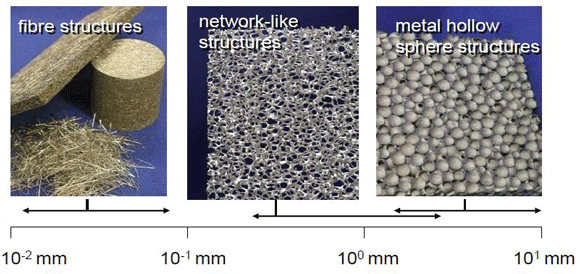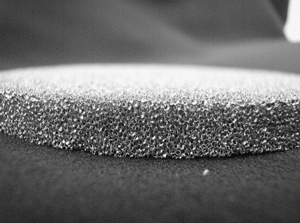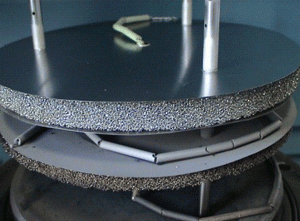Functional applications for cellular metals
A presentation at PM2010 World Congress, Florence, Italy, by Dr Günter Stephani and colleagues at the Fraunhofer-Institute for Manufacturing and Advanced Materials Research – IFAM, Dresden, Germany, reviewed the manufacturing technologies and highlighted a number of functional applications.
Manufacturing routes to cellular metals
Typical manufacturing technologies involve either the use of liquid metals in combination with blowing agents or bubbles, or the use of solid state methods. The term “solid state method” refers to the processing in the solid state, however in some cases limited amounts of liquid phase appear in the process, i.e. during liquid phase sintering or brazing of single cells.
Dr Stephani stated that typically, solid state methods require a sintering step before the final cellular metallic structure is obtained and that powder metallurgy methods play a dominant role in this area. The formation of the cellular structure can either be accomplished by building it up from single cells, which do not necessarily have to be in the final metallic state, or the structure can be built up from bulk. The formation of the cells themselves can either be carried out with the help of a lost core or in a coreless manner.
The physical properties of cellular materials essentially depend on their structure, their cell size and their porosity. Since these materials cover various types of structures and a wide range of pore sizes and porosities, miscellaneous applications were tested by Dr Stephani and his colleagues. Metal fibre structures and network-like structures with open cell porosity as well as metal hollow sphere structures with more or less closed cell porosity were developed. Cell sizes in the range of 10-2 – 101 mm and porosities in the range of 50 – 96% where produced.
Open porous metal fibre structures
In order to obtain open-porous fibre structures, Fraunhofer IFAM uses crucible melt extraction to yield short metal fibres with equivalent diameters as low as 50 µm from almost any type of metal and alloy. The highly porous components produced can be made from such fibres by suitable deposition and sintering methods.
Open cell network-like structures
Fraunhofer IFAM produce open cell metal foams by the replication method using polyurethane sponge as a template. The replication method essentially consists of three production steps. Firstly, a reticulated polyurethane sponge is coated by slurry infiltration. In the next step, the template is thermally removed and finally the brown structure is sintered. The method allows the manufacture of cell sizes in the range of 0.4 – 5.0 mm and porosities of 75 – 95%.
Hollow Sphere Structures
The author stated that the manufacturing of metal hollow sphere (MHS) structures is characterised by three main steps. The process begins with the powder coating of a styrofoam template, then shaping of the structure using the coated styrofoam spheres, removal of the styrofoam and finally sintering. A broad cell size spectrum from 0.5 – 10 mm is possible whereas the cell size distribution is very narrow. The cell wall thickness can be varied from approx 20 µm to 1,000 µm. The walls can be sintered fully dense as well as porous.
Material properties
The properties and combination of properties of cellular metal materials make them vastly different from that of their base materials. A reduction in weight and material usage, noise and energy absorption, low heat conductivity and excellent mechanical damping properties, good filtration capability and catalytic properties demonstrate their many application specific benefits.
It was highlighted by Dr Stephani that cellular metal materials exhibit key benefits for applications where stringent operating conditions require extraordinary combinations of properties. Due to their porous structure, they are extremely lightweight (up to 95% porosity), combined with a high specific strength and stiffness. At the same time, they feature low heat conductivities (approx. 1-5% of the matrix material) and sound absorption coefficients comparable to the values of polymeric damping material. Open cell metal foams are permeable, combined with a high specific inner surface. This set of properties is the basis for a variety of applications.
Applications
The author stated that numerous technologies have been developed in order to manufacture cellular metal materials. Because of the unique properties of the material, a variety of new applications have been tested by Fraunhofer IFAM. These include applications in the vehicle industry (diesel soot filtration, energy absorption, sound dissipation, heat insulation), for machine constructions (acoustic and mechanical damping, weight reduction), and for process engineering (weight reduction, sound absorption, catalytic reaction, thermal insulation, filtration, infrared burners). Other potential uses of metallic foams are as a replacement for bone structures, an application that was covered in an article on ipmd.net here.
Case Study: Molybdenum foams for furnace applications
Because of its high temperature strength, molybdenum is frequently used in kiln engineering for hot plates, heating element support and shielding plates. In recent years the price of molybdenum has increased dramatically. The Fraunhofer Institutes IFAM in Dresden and Fraunhofer IKTS also in Dresden in cooperation with H.C.Starck Hermsdorf GmbH have developed a lightweight molybdenum foam for heat insulation applications (Fig. XX), using the low heat conductivities of about 1-5% of the basic material. Network-like structures with porosities up to 95% and cell sizes of 0.8-1.2 mm were synthesised.
In early trials, the heat insulation capability of the new material was tested in an industrial vacuum furnace. The molybdenum foam was laminated by a thin molybdenum foil. In comparison to the conventional shielding plates, the temperatures at the cold zones only show differences of about 2% when the molybdenum foam heat insulation was used. At the same time, the mass of the heat insulation package was reduced by a factor of 4.
More information: www.ifam-dd.fraunhofer.de
News | Articles | Market reviews | Search directory | Subscribe to e-newsletter
Pulished on www.ipmd.net
News, articles and a fully searchable directory for the powder metallurgy industry








